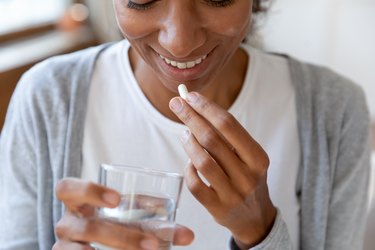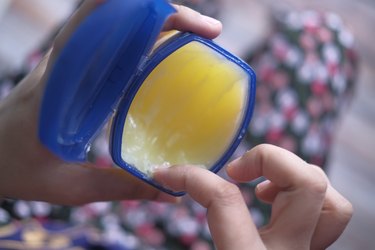
When you're in the throes of a vaginal yeast infection, you'll try almost anything to relieve the itching and burning, clear up the curdly white discharge and soothe your sore, swollen v-zone. But what's the deal with natural remedies like yogurt or coconut oil for your below-the-belt woes? Do they work?
First things first: "Once the symptoms of a yeast infection occur, it's best to contact your health provider for a confirmatory evaluation and treatment with an antifungal medication," says ob-gyn Kecia Gaither, MD, director of perinatal services at NYC Health + Hospitals/Lincoln and associate professor of clinical obstetrics and gynecology at Weill Cornell Medicine.
Video of the Day
Video of the Day
Yes, that even goes for folks who've had an infection in the past and feel certain they know what they're working with.
Why? Many people falsely believe they have a yeast infection when an STI, skin irritation, bacterial vaginosis or hemorrhoids are actually causing the symptoms. And if you've got a bun in the oven, it's even more important to discuss treatments with your doc, as some can harm the fetus.
As for home remedies? We're going to be upfront with you. Most of them have little to no positive effect, and some could even harm your honey pot. Read on for the full scoop, including what might be worth trying.
1. Eat Some Yogurt

Yeast infections are caused by an overgrowth of fungus in the vagina. Specifically: "Candida albicans is responsible for the majority of vaginal yeast infections," Dr. Gaither says.
Sounds yucky — but according to the Centers for Disease Control and Prevention, Candida is actually a harmless, normally occurring fungus that lives in your mouth, gut, throat and vagina. "The vagina contains a community of microbes within it, inclusive of bacteria and yeast," Dr. Gaither says.
During a yeast infection, though, the environment in your vagina changes in a way that lets Candida run wild.
"A particular bacteria known as Lactobacillus works to maintain a balance of these microbes," Dr. Gaither says. "But the balance can be disrupted by a number of factors, such as sex, douching, antibiotic usage or an impaired immune system."
Some of these — like douching or taking antibiotics — can kill off good bacteria like Lactobacillus and another, L. acidophilus, which keep Candida in check. Meanwhile, anything that messes with your hormone levels (pregnancy, hormonal birth control, even stress) can also lead to yeast infections.
OK…so what does all this have to do with yogurt? There's not much good research around food and yeast infections in general, but according to Columbia University, the bacteria L. acidophilus and Lactobacillus found in your cup of Danon has antifungal properties that can inhibit Candida's growth.
A small November 2015 study in the Global Journal of Health Science split people assigned female at birth (AFAB) with yeast infections into two groups. Half were given a vaginal cream made of yogurt and honey; the other half were given an anti-fungal cream. After applying the cream for 14 days, the infection had cleared up in 67 percent of those using the yogurt-honey mixture and 80 percent of those using the anti-fungal. A February 2012 study in General Gynecology found similar results among pregnant people.
A later study, published June 2017 in Egyptian Nursing Journal, suggested that eating yogurt can also help reduce the symptoms of a yeast infection. The study revealed that, in addition to receiving medical treatment, 88 percent of women who ate one cup of plain yogurt a day experienced yeast infection relief after two weeks, compared to 72 percent of those who didn't load up on Stonyfield.
Without clinical trials, we can't say for sure whether yogurt is your best bet. But if you want to give it a try, there's no harm in it — just pick one that's unflavored and unsweetened, and look for a label that says it contains "live cultures" or "active cultures." Dr. Gaither notes that regular yogurt consumption can also be preventative against future or recurring yeast infections.
Related Reading
2. Pop a Probiotic

In addition to upping your levels of Candida-fighting bacteria by gobbling yogurt, probiotics could have a positive effect on a yeast infection. "Taking daily Acidophilus tablets, which contain Lactobacillus, might help and is safe in pregnancy," Dr. Gaither says.
A January 2020 study in Microorganisms found that lactobacillus probiotics "represent a very promising tool" to protect people AFAB from vaginal yeast infections — but researchers noted that a high-quality supplement is imperative.
One to try: Metagenics UltraFlora Women's ($44.45 for a 30-day supply, Amazon.com).
3. Apply Vaseline to Your Vulva

If your vulva is also irritated, the Cleveland Clinic says coating the area with a thick ointment like Vaseline ($12.51 for a pack of 3, Amazon.com) or Aquaphor ($9.58, Amazon.com) can reduce itching and prevent the infection from spreading.
Note that this is by no means a cure; rather, it's a way to manage symptoms while you wait to see your doc.
What About Coconut Oil?
An April 2019 lab study in Microbiology Research Journal International found that virgin coconut oil exhibited antifungal activity against Candida albicans, the primary fungus at play in a yeast infection.
But keep in mind that this was an in-vitro (test tube) experiment, and there's no clinical data about how it might work (or not) in the human v-zone.
What About Drinking Lots of Water?
Hey, we're always pro-hydration — but contrary to popular belief, chugging H2O won't "flush out" a yeast infection. (Same goes for cranberry juice.)
Although drinking water can help prevent recurring urinary tract infections, according to a February 2019 study in BMJ Open Medicine, there is zero evidence suggesting it can banish Candida.
What About Apple Cider Vinegar?
Could this health food staple help clear up Candida? Some people believe that applying apple cider vinegar south of the border can inhibit the growth of fungus — and a January 2018 study in Scientific Reports found that ACV had antimicrobial effects on good old Candida albicans.
But before you douse your parts in ACV, hear this: The Cleveland Clinic points out that vinegar, which is highly acidic, causes burning and irritation in this sensitive area. No thanks!
And definitely don't douche with vinegar. "The vagina is a self-cleaning, delicate organ," Dr. Gaither says.
According to the HHS, douching with vinegar (or anything, for that matter) can worsen yeast infections and lead to serious health issues such as pelvic inflammatory disease. If you're pregnant, it's even more important to steer clear, as douching has been linked to preterm labor and ectopic pregnancy.
What About a Saltwater Rinse?
While the Cleveland Clinic suggests that rinsing with salt water can soothe an oral yeast infection (aka thrush) thanks to its antiseptic properties, there's no evidence that it helps with the vaginal version.
Other Popular 'Remedies' to Avoid
They may be common in your friend circle or on social media, but these yeast infection "remedies" should be avoided at all costs, as there's no reason to believe they work and they may even make things worse:
- Essential oils (such as tea tree oil or oil of oregano)
- Hydrogen peroxide
- Garlic
The Normal Timeline for a Yeast Infection
Typically, the first signs of a yeast infection include the following, according to Planned Parenthood:
- Itching in your vagina or on your vulva
- Discomfort during sex (caused by friction against your irritated skin)
- Redness, burning and/or swelling in the area
- A thick, clumpy, white vaginal discharge that resembles cottage cheese but does not have an odor
Although there's a chance that a mild yeast infection might go away on its own, the infection can also progress over time, possibly causing itchiness to intensify and pain when you pee, according to Planned Parenthood. If the infection becomes more severe or you scratch at the area, you might develop sores or abrasions on your vagina or vulva that can spread the infection.
Once you begin treatment with an anti-fungal cream or pill, symptoms will start to subside within a few days. But again, check with your doctor before taking any meds for a yeast infection — especially if you're pregnant. And see your doctor if the infection doesn't begin to clear up after a week of treatment.
- HSS: "Vaginal yeast infections"
- CDC: "Vaginal Candidiasis"
- Columbia University: "Yogurt for yeast infections?"
- Global Journal of Health Science: "The Comparison of Vaginal Cream of Mixing Yogurt, Honey and Clotrimazole on Symptoms of Vaginal Candidiasis"
- General Gynecology: "Bee-honey and yogurt: a novel mixture for treating patients with vulvovaginal candidiasis during pregnancy"
- Egyptian Nursing Journal: "Effect of ingestion of yogurt containing Lactobacillus acidophilus on vulvovaginal candidiasis among women attending a gynecological clinic"
- Microorganisms: "Warding Off Recurrent Yeast and Bacterial Vaginal Infections: Lactoferrin and Lactobacilli"
- Cleveland Clinic: "Do Home Remedies Actually Work for Yeast Infections?"
- Microbiology Research Journal International: "In vitro Evaluation of Antifungal Activity of Virgin Coconut oil and White Palm Kernel Oil on Candida Species-Experimental Study "
- BMJ Open Medicine: "Can drinking more water prevent urinary tract infections? The evidence says yes"
- Scientific Reports : "Antimicrobial activity of apple cider vinegar against Escherichia coli, Staphylococcus aureus and Candida albicans; downregulating cytokine and microbial protein expression"
- Cleveland Clinic: "How To Get Rid of Thrush: 8 Remedies"
- Planned Parenthood: "What is a yeast infection?"
Is this an emergency? If you are experiencing serious medical symptoms, please see the National Library of Medicine’s list of signs you need emergency medical attention or call 911.